Killer Paradox 5 for Windows
This book presents advanced Paradox developers with a better understanding of Paradox and ObjectPAL (its programming language). It also provides many practical techniques
>> Learn MoreThis book presents advanced Paradox developers with a better understanding of Paradox and ObjectPAL (its programming language). It also provides many practical techniques
>> Learn MoreThis presentation was developed for the Southern California ColdFusion User Group (sccfug) and was first presented
>> Learn More|
We provide services that span the entire range of the system development life cycle. We provide: e-Business Solutions>> Learn MoreWeb application / intranet / extranet development Since 1997, our practice has been focused on developing custom web applications. These have ranged from simple, on-line brochures to
complex e-commerce applications. We have focused on use of Adobe's ColdFusion since it's first release in 1995. We have subseuently
built a wide variety of solutions that employ a variety of Internet technologies including: Clients that creating a new web sites or enhancing existing sites may require assistance from an objective party with regards to establishing goals and strategies for their web site. We have the objectivity, the understanding of the Internet and skills to assist in this planning process. We also provide web site hosting services for select consuling clients when requested and there's a good fit. Moreover, we can help clients devise the mechanisms that they may need to track the success of their site. Back Office Solutions>> Learn MoreWe have over a decade of experience developing and supporting back office systems for a variety of clients in different
industries. We have built a variety of solutions: |
We're happy to provide hosting services for select consulting clients (i.e., clients for whom we are doing development work). Over the years a number of clients have asked us to host applications and sites that we've developed for them. While hosting websites is not the focus of our business, it is a service that we feel obliged to provide for clients who request it as they are unable to find satisfactory hosting firms elsewhere.
Our rates and terms will be competive with companies providing similar services (e.g., use of ColdFusion, SQL Server, highly responsive technical support, SSL, secured FTP accounts, email, etc.).
We generally provide quotes on a monthly basis. Prices fluctuate and will be a function of the services and levelof service required.
Support work, other than issues related directly to hosting the site, is not included in the hosting fees and will be charged for at our normal billing reates for consulting.
Hosting services are provided on a monthly basis and renew each month automatically. Monthly fees are are invoiced prior to rendering service for the month.
We charge for web-site setup and configuration on an hourly basis at our standard rates for consulting work.
|
ART is a web-based incident tracking system. It is an ideal solution for lowering
support costs while providing better service. [ details ] |
|
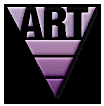 |
Minimum Requirements: - Windows 2000 and higher - Adobe's ColdFusion MX or higher - 4 MB of Disk space for installation* - 8GB of RAM - IE7 or above * After installation, hard disk space is a function of the data being tracked. |
|
Price : $2,495 Options : - Allow 'public' users, projects and ARs + $800 |
|
|
Demo Please contact us for a demonstration. |
|
|
We provide training in two formats.
Training can be performed on your premises, at our office or in a convenient, rented facility. Our training is focused on ColdFusion, but includes:
Our advantageWe are professional systems consultants. We build applications for a living, not as an adjunct to our training practice. We have a vast array of experience building web-based solutions for different businesses, markets, technical environments and of different complexities. Our training materials were developed by Advanta Solutions principal, Leon Chalnick, a noted authority on ColdFusion and web application development. Our focus is on providing application developers with the additional tips and insights that you only get through real-world experience. |
|
This page presents a description of Advanta Solutions LLC's Action Request Tracker™ (ART), a web based incident tracking and knowledge base system. Contact and background information
Advanta Solutions' goal is to deliver information technology to its clients through systems architecture and design, custom applications development and technology transfer. We do this by striving to understand our clients' business as well as their technical needs. We also strive to minimize the risk involved with developing and delivering applications to its clients. Our professionals utilize a systems development methodology that has been developed and refined from years of practice in the field. We also bring to the table multi-vendor expertise. This ensures our clients that we will find the technical solution that is most appropriate for their specific situation. In short, our strategy is to deliver real world, proven technology to clients to solve their complex business problems. Overview ART enables a support group (we’ll refer to them as support engineers) and end users to track action requests (ARs) and status reports pertaining to supported projects (or systems). It enables a group of people involved in a particular project to communicate with each other about a set of action items and their status via an Intranet or over the Internet. While this description closely models a help desk, it can be applied to many other business functions. ARs are typically problem reports, enhancement requests, questions or help requests. Support team members (or support engineers) respond to action requests by investigating the request and filing status reports. Solutions to common problems can be logged and made available for searching as well. The system is intended to be relatively small in focus, but flexible, configurable and powerful. The Hot List When you log into ART (there’s an authentication process), you see a "hot list" of the open action requests relating to projects in which you’re a member. A graphical image indicates the priority of each action request item. For example, items with the highest priority appear with a blinking red light. The hot list includes some basic information about each AR:
See Figure 1. 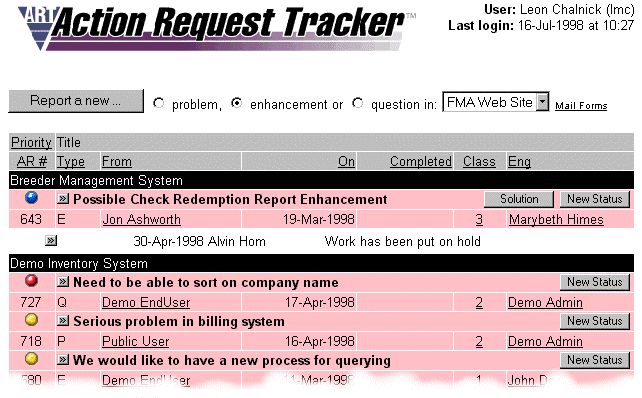 Figure 1—ART's Hot List displays unresolved action requests You can sort the hot list on any of these fields. Each AR also includes a brief (60 character) description or title. You also see the support engineer's responses to the action request as soon as they’re filed. These are called "status reports". They appear below the action request, sorted in reverse chronological order. Most data items in the hot list are hot linked to detail information. For example, clicking on the AR priority displays a list of all priorities, indicating the current priority. Clicking on a user’s name displays a list of users with access to the current project. Clicking on the AR (or status report) entry presents a detail page which includes all data to which you have access. Each AR in the hot list has a button for creating a new status report, if you have rights to create a status report. If an AR has a Solution, the AR entry in the hot list will contain a link to the solution. Your hot list display is quite configurable. If you support multiple projects, you have the ability to indicate how you want your hot list sorted with respect to your projects. You can also specify that different types of ARs or entire projects are to be filtered out of your hot list display. Several other settings enable you to determine when items should no longer appear in your hot list display. Old/completed items can be reviewed through a flexible search engine discussed later in this document. 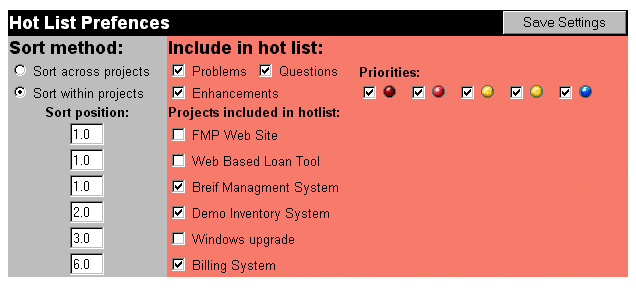 Figure 2—Each user specifies her or his hot list preferences Filing Action Requests When action requests are filed, an e-mail notification will always be sent to the support person who has been designated as the "main contact" for the project. The AR can be sent to a specific support person as well and you can optionally "cc" every member of the project who has been configured to receive automatic e-mail notifications. In addition to the fields already described, action requests include:
Status report summaries appear at the bottom of each AR form and if a solution has been created for the AR, it appears below the status report summaries. If you have been given the right to create solutions, you can create a solution entry for the AR right from the AR page. Solutions are typically used to summarize steps involved in solving a problem. They can be used to form a knowledge base of solutions to common problems. ARs can also be filed by e-mail, using a simple form, provided with instructions. This will be extremely handy for users who prefer not to have to log into a web site and fill out forms. Filing Status Reports Support engineers are then responsible for filing status reports against the action requests. They can assign their own classifications to each AR. Each status report is assigned a disposition as well. The dispositions are assigned, like the priorities and classifications, from a list stored in a lookup table. The support team has access to a "private" field in each status report, which only other support team members can see. Eventually, a support person indicates that an action request has been completed. E-mails can be generated whenever status reports are filed, whenever action requests are filed and whenever either of the two is edited. When an AR is being marked as complete, the support person can easily create a solution entry—the form is right on the same screen with the status report form in addition to its location on the AR form. Like ARs, status reports can also be filed by e-mail, using a simple form, provided with instructions. This will be extremely handy for users who prefer not to have to log into a web site and fill out forms. The System Administrator A system administrator (SA) creates "customer/company" records. For each "customer/company" that you're supporting, the SA can create different "projects". Or, if you prefer, you can simply run everything under one customer/company. The SA also creates user profiles and associates them with various projects in which they become members. The SA has access to all projects and all user profiles and can assign system administrator privileges to other users. ART also provides for project administrators, who have system administrator-like capabilities, but only within one project. This is intended to enable the system administrator to offload certain administrative tasks to people involved with a specific project. There are no limitations on the number of system administrators or project administrators that you can create. 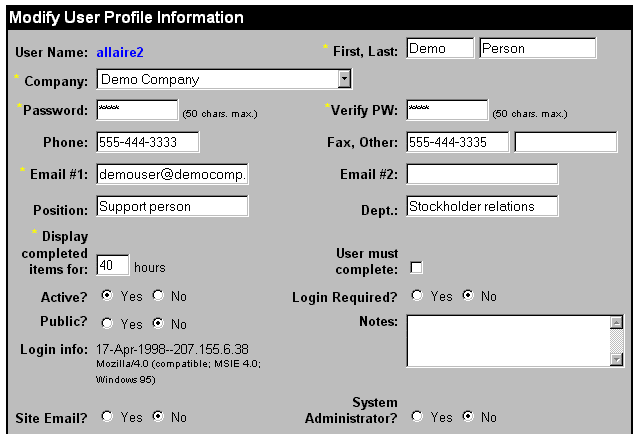 Figure 3—Modifying a user's profile Users’ access is limited to the projects in which they are members. (Public users, an exception to this rule, are discussed below.) Included in the typical project are:
User Profiles In the basic version of the system, every user needs to have a user profile record in order to login and use ART. Technically, there aren't any pre-defined "user types" as we believe most organizations will find this approach too confining and inflexible. You can assign any user a variety of privileges (described further below), and these privileges determine what the user can and can’t do when working on projects managed within ART. This makes ART extremely flexible. User profile prototypes If you had to explicitly assign privileges every time you created a new user profile, the system would become rather cumbersome. We have avoided this problem by creating prototypes of the common user profiles. You can use a prototype when building a new user profile and this saves you the effort of having to explicitly assign privileges and other configuration information. Once you’ve created a user profile from a prototype, you have the ability to customize it in any way you see fit. While we’ve included a few prototypes to get you started, SAs have the ability to modify and remove these prototypes and create their own. Public Projects, Users and Action Requests ART includes an optional feature called "Public Users". This feature enables you to create projects that anyone on your network can access—without having a user profile record in advance. This will be ideal if you’re supporting large, enterprise-wide projects that many, many users need access to (e.g., rolling out Windows ’98). When a user who doesn’t have a profile tries to log in, he is prompted to create a basic profile. Once created, he is shown the hot list containing only action requests for projects that have been classified as "public". Actually, he’ll only see action requests (in public projects) that either he personally created, or that have been flagged as public action requests by the project administrator. He can create new action requests in the public projects and he can review any public ARs and status reports in public projects (that were flagged as public or that he created). As with regular projects, only users who have been assigned the privilege are able to respond to public ARs. User Privileges Privileges (or rights) are applied either "system wide" or on a project by project basis. System wide privileges include:
Project specific privileges indicate:
Submitting ARs and Status Reports by e-mail ART enables users to submit action requests and status reports by using some easy to use e-mail forms. Users are sent a confirmation when their e-mail has been entered into the database. Error messages are sent back if the e-mail they sent was invalid or couldn't be parsed properly. In the e-mail forms, users can indicate whether other people are to get copied on the new entry into the database. Searching and reporting There is a flexible searching front end (see Figure 4) that enables you to search on a variety of fields and produce two types of output. Search fields include:
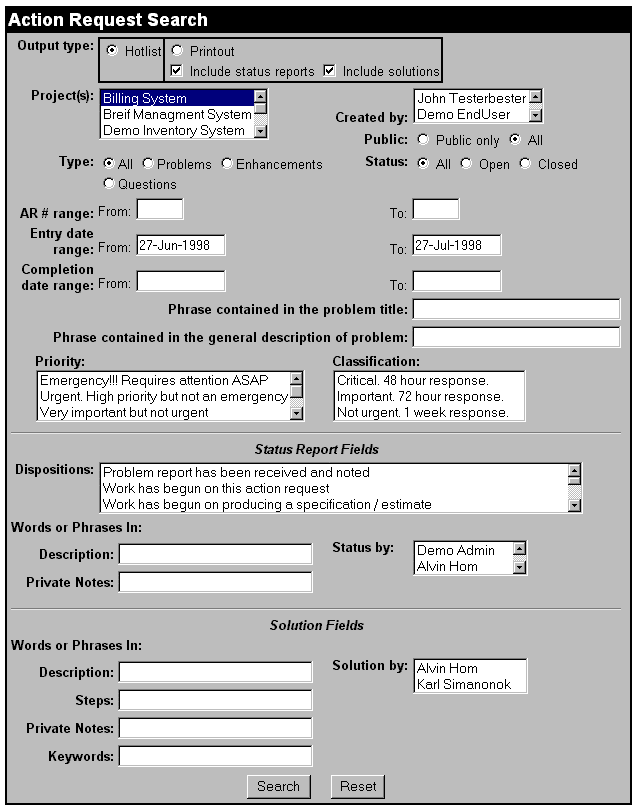
Figure 4—ART’s searching front-end Output can be in one of two formats. The hot list display format enables you to link to AR, status report and solution detail. The printout format presents ARs and status reports so that they are suitable for printing. Statistical reports ART enables you to build reports that provide a number of basic statistics—like counts. For almost every statistic, ART’s flexible report generator enables you to build cross-tabs against other statistics. For example, you can produce cross-tabs to answer questions like "How many ARs were serviced by individual support person based on the AR’s priority?" and "What is the average duration to complete ARs based on priority and project?" While the mechanisms for building the statistical reports have been completed, we are developing a solution that will provide output for certain statistics in graphical format. Installation At this time, we anticipate creating an "Install Shield" installation program that will copy all of the ColdFusion scripts to your web server’s hard drive. Customers must already have ColdFusion or must purchase it in addition to ART. A separate configuration utility will be used to configure ART with some basic information such as the names of your POP and SMTP servers (required to support ART’s email functions). We anticipate providing consulting services to assist customers with the installation and configuration of ART. We will be able to provide training services as well. Technical overview and requirements ART is a web/data-based action request tracking / help desk system which employs open Internet technologies like SMTP and POP3 to enable users to keep track of and resolve problems and other action requests. It was built using Adobe's (www.adobe.com) ColdFusion Application Server v3.1 in the NT 4.0 environment. We currently are running against an MS Access back end using straight ANSI 92 SQL. It can be upgraded to run against any ODBC database (e.g, MS-SQL Server, Oracle, dBase, etc). ART requires:
Minimum Requirements: |